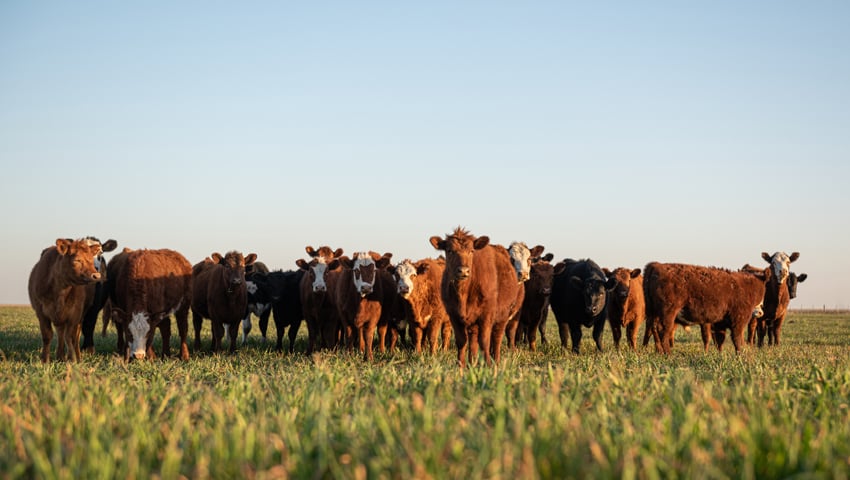Article by ffinlo Costain, 8point9 Editor-in-Chief.
Cattle – when they’re well reared – are ecological powerhouses.
In agroecological systems they can more than completely recycle the carbon they produce, while stimulating mass microbial activity, boosting biodiversity regeneration and ensuring high functioning air and water cycling in the soil.
Could 2025 finally be the year that environmentalists, the media and policymakers start to look beyond cattle ’emissions’ and begin to value the power of the ruminant in regenerative food systems?
To be anti-cow is anti-climate
To make this happen, we need a concerted effort to win back public support for the cow. (I’m using the cow as an emblematic shorthand for all ruminants.)
It’s time to push back at the dangerous propaganda from anti-meat activists, who for years have successfully used carbon emissions as a proxy to demonise farmers and their grazing livestock.
To be clear – this is not an anti-vegetarian or anti-vegan statement – people’s food choices are their own. But, disastrously for humanity, years of misguided anti-meat rhetoric from environmental NGOs and their friends in the mainstream media has sought to put all meat production into the same destructive basket.
It’s the how, not the cow – and the confusion caused by anti-meat and dairy campaigners has slowed progress on ecological regeneration just as effectively as any populist anti-climate flourish from the likes of President Trump or Nigel Farage.
As I set out in my 2022 TEDx Talk, “The climate crisis isn’t just about greenhouse gas emissions – climate change is driving and driven by biodiversity loss; climate change is driving and driven by desertification. […] In a regenerative farm system, producing high-functioning grassland, our cow helps the soil to sequester carbon, she restores land and ecological connectivity… helping us to solve the climate crisis – while at the same time producing fantastic nutrient dense food, supporting livelihoods and feeding communities right the way around the world.”
Regen revolution
Regenerative agriculture is the best tool humanity has in its belt to revolutionise land use and to address the ecological crisis in-the-round.
Carbon emissions are important, but they’re not the only game in town – and while I’ve been accused of climate denialism by those who’ve failed to update their knowledge, it is not remotely heretical to say that we should factor both sides of the carbon equation.
When we assess the whole of the carbon cycle, we find that even traditional set-stocking in UK seasonally-grazed ruminant systems can deliver substantial carbon drawdown – but in well-managed regeneratively grazed cattle systems the drawdown rates can surpass even UK woodland sequestration.
In e-mail correspondence, Forestry England confirmed that standard unmanaged sycamore/ash/alder/birch woodland delivers drawdown of around 6 tCO2e/ha/yr – but in the remarkable Roots So Deep, Peter Byck found drawdown rates of 11-13 tCO2e/ha/yr from his multi-year adaptive multi-paddock grazing research across the USA.
Multi-outcome land-use
Holistic thinking is essential in any land use conversation.
Single issue lenses distort the picture, sometimes to such an extent that we can no longer see the paint for the paper.
But now, at last, it seems to me that all but the most ardent anti-cow campaigners seem to have started to recognise the importance of the bovine in accelerating regenerative processes.
And while there are still those who promote an emissions-only lens, there is an increasing (albeit grudging) acceptance that ruminants play a critical role in regenerating natural processes. This acceptance usually manifests itself in excitement about historic or wild breeds, but at least it’s a start.
More than carbon
So, to set us off on the front hoof this January, let’s celebrate the fact that regenerative grazing systems deliver not only efficient carbon cycling – but so much more as well.
In systems that actively manage high ruminant impact, alongside long periods of rest, soil biodiversity thrives, setting off a chain reaction of below-ground community life and death that stimulates air and water flows in the soil.
This healthy soil holds and stores more water, preventing flooding and extending the growing season into long dry summer periods. It provides the building blocks for above-ground biodiversity restoration.
Transitional challenge
For clarity, I’m not saying that the regenerative transition is without its challenges. Regen will require changes in land management, crop choices, supply chain power and public diets.
Regenerative farming at its best aims to take a land up approach, with farmers asking, “what can I grow here?” instead of imposing petrochemical dependency through inappropriate commodity cropping.
In Britain – which grows grass really well – we may actually need to increase our ruminant herd size to deliver nationwide ecological regeneration. At the very least we should actively support livestock redistribution towards the east, to better support nutrient cycling in the UK’s arable producing areas.
The Year of the Cow?
So, could 2025 be the Year of the Cow – the year when the media and politicians finally start to recognise that regenerative ruminant agriculture plays a critical role in the nation’s ecological health?
If we focus on the positive impacts of regeneration – if we join the dots clearly – if we target fossil-fuel reductions and biodiversity renewal – if we celebrate land use that completes the carbon cycle – then maybe, just maybe, we might see more calls for the cow, and a strengthening of our ecological security.
